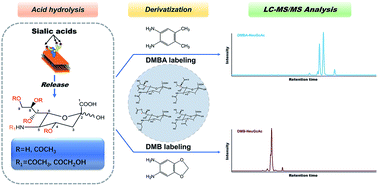LC-MS in combination with DMBA derivatization for sialic acid speciation and distribution analysis in fish tissues†
Abstract
Sialic acid (Sia) is widespread in vertebrates and humans as well as in some microbes and invertebrates. It is well known that O-acetylation is a common modification for Sia. Also, highly O-acetylated Sias have been reported in humans, bovines, and fish. Derivatization based on 1,2-diamino-4,5-methylenedioxybenzene (DMB) coupled with LC-fluorescence detection or LC-MS analysis has been the routine analytical strategy for O-acetylation profiling of Sias. Unfortunately, DMB offers poor chromatographic resolution for some O-acetylated species. Herein, we report another derivatization reagent, 4,5-dimethylbenzene-1,2-diamine (DMBA), for the LC-MS analysis of Sia isomers. The DMBA method was first evaluated using Sia reference standard, horse serum and carp blood. The results demonstrate that DMBA provides superior chromatographic separation efficiency and comparable MS/MS spectra to DMB. The proposed method was then applied to the analysis of relative abundance of each Sia species in fish tissues, including liver, intestine, muscle and brain. It was found that the relative amounts of Sia species were significantly different among the four tissues. Thus, DMBA derivatization-based LC-MS methods have great potential in investigating the O-acetylation level of Sias in various samples, such as human food and bio-pharmaceutical products.



 Please wait while we load your content...
Please wait while we load your content...